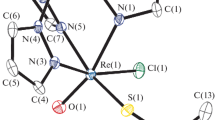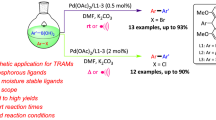Abstract
Reaction of TaCl(NMe2)4 (1) with KTp* [Tp* = tris(3,5-dimethylpyrazolyl)borohydride] yields two products: Tp*Ta(NMe2)4 (2), in which one N atom of the Tp* ligand binds to Ta, and [Tp*Ta(NMe2)4]·2KTp* (3) where three N atoms of the Tp* ligand in [Tp*Ta(NMe2)4] (2a) bind to Ta. Addition of excess 1 to 3 did not exclude KTp*. Further reaction of 2 with oxygen affords Tp*BH(NMe2) (4). TpTa(NMe2)4 (5) has been synthesized by a similar procedure through the reaction of 1 with TpK [Tp = tris(pyrazolyl)borohydride]. Reactions of 3 and 5 with oxygen were also studied. 2, 4, and 5 were characterized by NMR, EA, and single-crystal X-ray diffraction.
Similar content being viewed by others
References
Herzon S B, Hartwig J F. Direct, catalytic hydroaminoalkylation of unactivated olefins with N-alkyl arylamines. J Am Chem Soc, 2007, 129: 6690–6691
Nugent W A, Ovenall D W, Holmes S J. Catalytic C-H activation in early transition-metal diaikyiamides and alkoxides. Organometallics, 1983, 2: 161–162
Chisholm M H, Extine M W. Reactions of transition metal-nitrogen σ bonds. 3. Early transition metal N,N-dimethylcarbamates. Preparation, properties, and carbon dioxide exchange reactions. J Am Chem Soc, 1977, 99: 782–792
Chisholm M H, Extine M W. Reactions of transition metal-nitrogen σ bonds. 4. Mechanistic studies of carbon dioxide insertion and carbon dioxide exchange reactions involving early transition metal dimetnylamido and N,N-dimethylcarbamato compounds. J Am Chem Soc, 1977, 99: 792–802
Hellwig M, Milanov A, Barecca D, Deborde J-L, Thomas R, Winter M, Kunze U, Fischer R A, Devi A. Stabilization of amide-based complexes of niobium and tantalum using malonates as chelating ligands: Precursor chemistry and thin film deposition. Chem Mater, 2007, 19: 6077–6087
Peters E S, Carmalt C J, Parkin I P, Tocher D A. Aerosol-assisted chemical vapor deposition of NbS2 and TaS2 thin films from pentakis (dimethylamido)metal complexes and tert-butylthiol. Euro J Inorg Chem, 2005, 20: 4179–4185
Chen T, Xu C, Baum T H. Tantalum amide complexes for depositing tantalum-containing films, and method of making same. US Patent, 2003-684545, 2003-10-14
Takai K, Oshiki T, Michigami K, Tsurugi Y. Ring-opening metathesis polymerization catalysts and manufacture of ring-opened metathesis polymers. Japanese Patent, 2007-130313, 2007-05-16
Takai K, Oshiki T, Michigami K. Olefin polymerization catalysts containing transition metal compounds having pyrazolyl ligands and method for olefin polymerization therewith. Japanese Patent, 2007-73563, 2007-03-20
Etienne M, Hierso J-C, Daff P J, Donnadieu B, Dahan F. Mono and dinuclear hydrotris(3,5-dimethylpyrazolyl)borato tantalum complexes. Polyhedron, 2004, 23: 379–383
Schorm A, Sundermeyer J. Silylimido complexes of niobium and tantalum at the limit of π-bond saturation. Euro J Inorg Chem, 2001, 11: 2947–2955
Hierso J-C, Etienne M. Alkyne[hydrotris(pyrazolyl)borato]tantalum complexes-An ethyl group is a better α-agostic donor than a methyl group. Euro J Inorg Chem, 2000, 5: 839–842
Rodriguez G, Graham J P, Cotter W D, Sperry C K, Bazan G C, Bursten B E. Binding preferences of the tribenzylidenemethane ligand in high-oxidation-state tantalum complexes. J Am Chem Soc, 1998, 120: 12512–12523
Mashima K, Oshiki T, Tani K. Tp*Sn(Cl)Bu2 as a convenient reagent for the preparation of hydrotris(3,5-dimethylpyrazolyl)borate complexes of niobium, tantalum, and zirconium. Organometallics, 1997, 16: 2760–2762
Boncella J M, Cajigal M L, Gamble A S, Abboud K A. Synthesis and crystal structures of hydridotris(3,5-dimethylpyrazolyl)borate tantalum(V)(=N-2,6-iPr2C6H3)(X)Cl (X = Cl, BunO). Polyhedron, 1996, 15: 2071–2078
Boncella J M, Cajigal M L, Abboud K A. Competition between π Donation and α-C-H agostic interactions in complexes of the type Tp′Ta(=CH-t-Bu)(X)(Y) (X = Halide; Y = Halide, NR2, OR; Tp′= Hydrotris(3,5-dimethylpyrazolyl)borate). Organometallics, 1996, 15: 1905–1912
Sundermeyer J, Putterlik J, Foth M, Field J S, Ramesar N. Highervalent derivatives of the d-metal acids, 13. Homoscorpionates as tripodal anchoring ligands of chloro functionalized oxo and imido complexes of elements of group 5–7. Chem Ber, 1994, 127: 1201–1212
Reger D L, Swift C A, Lebioda L. Poly(pyrazolyl)borate derivatives of chlorotrimethyltantalum(V). Synthesis, crystal structure, and stereochemically nonrigid behavior of seven-coordinate molecules. Inorg Chem, 1984, 23: 349–354
Cai H, Lam W H, Yu X, Liu X, Wu Z-Z, Chen T, Lin Z, Chen X-T, You X-Z, Xue Z. Synthesis, characterization, and theoretical studies of group 4 amido hydrotris(pyrazolyl)borate complexes. Inorg Chem, 2003, 42: 3008–3015
Chen S J, Cai H, Xue Z L. Crystal structure of TaCl(NMe2)4 and its reactions with amide and water. Indirect observation of an equilibrium among TaCl(NMe2)4, Ta(NMe2)5 and Ta2(μ-Cl)2(NMe2)6Cl2. Organometallics, 2009, 28: 167–171
Sheldrick G M. SADABS: A program for empirical absorption correction of area detector data. Göttingen: University of Göttingen, 2000
Sheldrick G M. SHELXL-97: A program for the refinement of crystal structures. University of Göttingen, Göttingen, 1997
Trofimenko S. Scorpionates. The Coordination Chemistry of Polypyrazolylborate Ligands. London: Imperial College Press, 1999
Pettinari C. Santini, C. Polypyrazolylborate and scorpionate ligands. In: McCleverty J A, Meyer T J. eds. Comprehensive Coordination Chemistry II. Vol. 1. Oxford: Elsevier. 2004. 159–210
Chen S-J, Zhang X-H, Yu X, Qiu H, Yap G P A, Guzei I A, Lin Z, Wu Y-D, Xue Z-L. Reaction of Ta(NMe2)5 with O2: Formation of aminoxy and unusual (aminomethyl)amide oxo complexes and theoretical studies of the mechanistic pathways. J Am Chem Soc, 2007, 129: 14408–14421
Author information
Authors and Affiliations
Corresponding author
Additional information
Supported by the US National Science Foundation (CHE-051692)
Rights and permissions
About this article
Cite this article
Chen, S., Yap, G.P.A. & Xue, Z. Synthesis and characterization of poly(pyrazolyl)borate tantalum amide complexes and their reactivities toward oxygen. Sci. China Ser. B-Chem. 52, 1583–1589 (2009). https://doi.org/10.1007/s11426-009-0236-3
Received:
Accepted:
Published:
Issue Date:
DOI: https://doi.org/10.1007/s11426-009-0236-3




